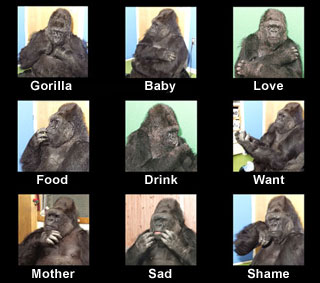Animals and language
Over the past several years I’ve read quite a few items about about primates using American Sign Language, and other forms of animal-to-human communication. If you follow this blog, you know I’m reading Spencer Wells’ The Journey of Man. Here’s a passage about animal language that I had not seen, and it clarifies some things for me, so I thought I’d share. The whole book is worth a read, and if your library doesn’t have it, put in a book request.
… It is at this age that most children begin to put together three words into complex sentences – ‘Margot kiss Daddy’, rather than simply ‘Margot kiss’ or ‘Kiss Daddy’ – with the subject-verb-object (SVO) structure, or syntax, that characterizes English and most other human languages. The structure SOV (‘Margot Daddy kiss’) is used by a few languages (Japanese, Korean, and Tibetan among others), while VSO and VOS structures are used by around 15% of languages (Welsh is an example of the former and Malagasy of the latter). The rarest structure of all is OSV, perhaps best known from the film The Empire Strikes Back as the language of Yoda the Jedi master: ‘Sick have I become’ and so on, used by only a handful of languages spoken in the Brazilian Amazon.
The important thing to glean from this syntactic diversity is that word order plays a crucial role in our understanding of a sentence. …
So, the explosion of linguistic complexity in a two-year-old is a result of the mastery of syntax, and from then on it is a never-ending barrage of ever more complex sentences. The great leap forward in understanding, however, involves crossing the syntax barrier… This is what we see with chimpanzees taught to use American Sign Language … The significant difference in human vs. ape communication seems to have been the creation of brain structures that allowed an understanding of syntax, and thus the communication of complex meaning.
This is a more extended passage than I usually quote, but the remarks about chimps and syntax don’t make a lot of sense without the examples of syntax. The whole section is good. (Pages 86 and 87 if you look it up.) I had been wondering if there was a qualitative difference between ape and human language ability beyond anatomical hindrances in the chimp. Now I see there is.


Leave a Reply